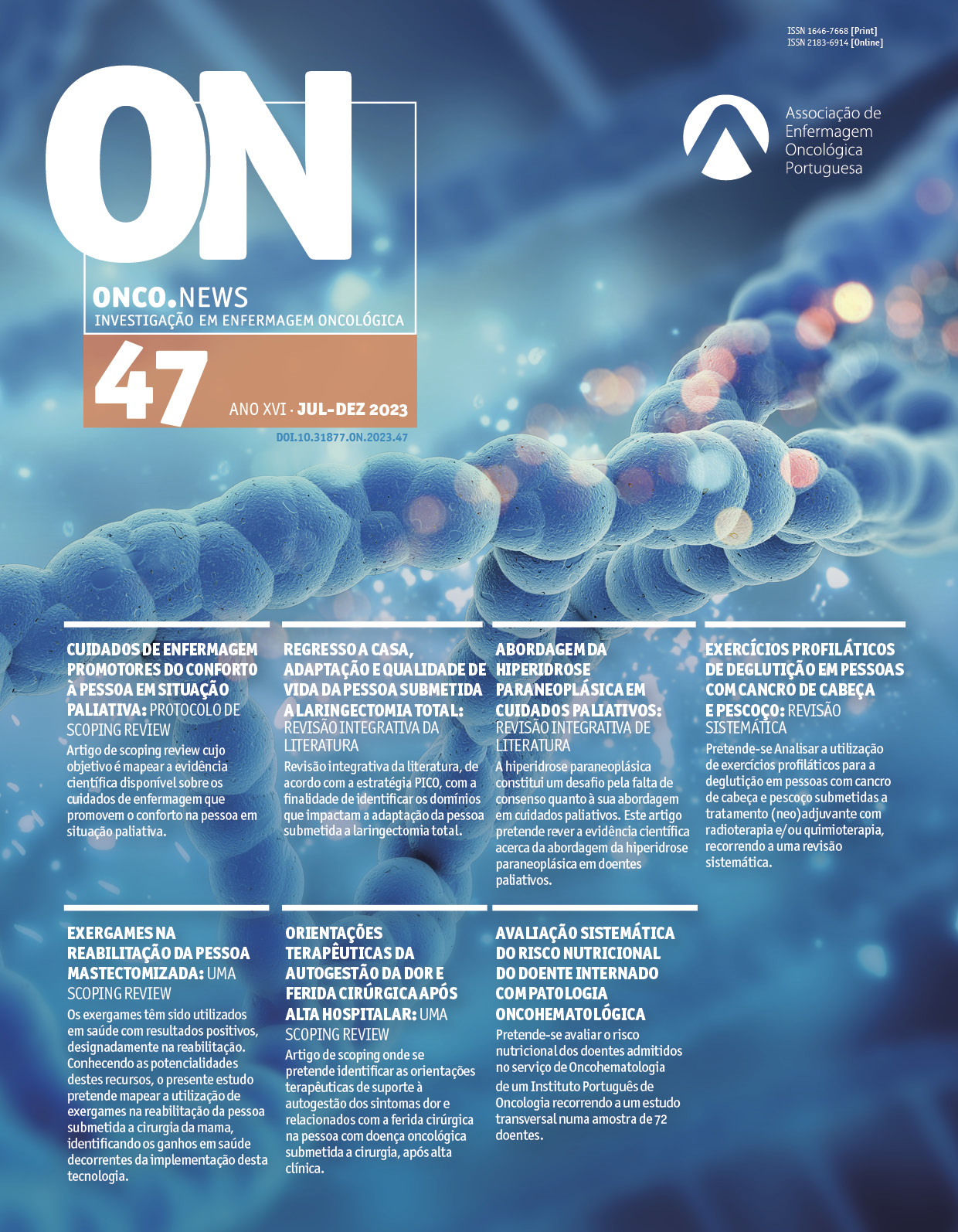Abordagem da hiperidrose paraneoplásica em cuidados paliativos: revisão de literatura
DOI:
https://doi.org/10.31877/on.2023.47.01Palavras-chave:
Hipersudorese, Hiperidrose, Cuidados paliativos, Medicina paliativa, Cuidados de confortoResumo
Introdução: Com este artigo pretende-se rever a atual evidência científica existente acerca da abordagem da hiperidrose paraneoplásica em doentes em cuidados paliativos.
Métodos: A pesquisa foi realizada na MEDLINE/Pubmed®, Cochrane, DARE®, BMJ EBM®, NICE®, CMAJ® e Bandolier, utilizando-se os termos MeSH “Sweating”, “Hyperhidrosis”, “Palliative Care” e “Palliative Medicine”. Para avaliar a qualidade dos estudos incluídos recorreu-se à escala de Oxford.
Resultados: Nesta revisão foram incluídos 13 artigos sobre a abordagem da hiperidrose paraneoplásica. As intervenções avaliadas nestes estudos incluíram o uso de tioridazina, talidomida, olanzapina, gabapentina, canabinóides, acupunctura e fitoterapia chinesa. Os resultados encontrados foram heterogéneos e, apesar de na sua generalidade parecerem mostrar vantagens no controlo da hiperidrose paraneoplásica em doentes sob cuidados paliativos, não existe evidência robusta que comprove o benefício inequívoco de uma abordagem em relação a outra.
Conclusão: A evidência atual sobre a abordagem terapêutica da hiperidrose paraneoplásica em cuidados paliativos é de qualidade fraca (Nível de evidência 4; Força de recomendação C).
Downloads
Referências
Nawrocki S, Cha J. The etiology, diagnosis, and management of hyperhidrosis: A comprehensive review: Therapeutic options. Journal of the American Academy of Dermatology [Internet]. 2019;81(3):669–80.
Mercadante S, Porzio G, Valle A, Fusco F, Aielli F, Adile C, et al. Orphan symptoms in advanced cancer patients followed at home. Supportive Care in Cancer. 2013 Oct 13;21(12):3525–8.
Tsai JS, Wu CH, Chiu TY, Chen CY. Significance of Symptom Clustering in Palliative Care of Advanced Cancer Patients. Journal of Pain and Symptom Management. 2010 Apr 1;39(4):655–62.
Grond S, Zech D, Diefenbach C, Bischoff A. Prevalence and pattern of symptoms in patients with cancer pain: A prospective evaluation of 1635 cancer patients referred to a pain clinic. Journal of Pain and Symptom Management. 1994 Aug;9(6):372–82.
Tsai JS, Wu CH, Chiu TY, Hu WY, Chen CY. Symptom patterns of advanced cancer patients in a palliative care unit. Palliative Medicine. 2006;20(6):617–22.
Zhukovsky DS. Fever and sweats in the patient with advanced cancer. Hematology/Oncology Clinics of North America. 2002 Jun;16(3):579–88.
Zasowska-Nowak A, Ciałkowska-Rysz A. Hyperhidrosis in palliative care patients. Medycyna Paliatywna/Palliative Medicine. 2017;9(2):79-83.
Cherny N, Fallon M, Kaasa S, Portenoy RK, Currow DC, editors. Oxford Textbook of Palliative Medicine. Oxford Medicine Online. Oxford University Press; 2015. p.724-739.
Dalal, S. Arthur, JA. Overview of sweating in palliative care. UpToDate. Consultado a 16 de novembro de 2022.
Twycross R. Sweating in advanced cancer. Advances in Palliative Medicine. 2004;3(2):179–88.
Quigley CS, Baines M. Descriptive epidemiology of sweating in a hospice population. Journal of Palliative Care. 1997;3(1):22–6.
Regnard C. Use of low dose thioridazine to control sweating in advanced cancer. Palliative Medicine. 1996;10:78–9.
Cowap J, Hardy J. Thioridazine in the management of cancer-related sweating. Journal of Pain and Symptom Management. 1998;15(5):266.
Abbas SQ. Use of thioridazine in palliative care patients with troublesome sweating. Journal of Pain and Symptom Management. 2004 Mar;27(3):194–5.
Deaner P. Thalidomide for distressing night sweats in advanced malignant disease. Palliative Medicine. 1998 Apr;12(3):208–9.
Calder K, Bruera E. Thalidomide for night sweats in patients with advanced cancer. Palliative Medicine. 2000 Jan;14(1):77–8.
Deaner PB. The use of thalidomide in the management of severe sweating in patients with advanced malignancy: trial report. Palliative Medicine. 2000;14(5):429-31.
Zylicz Z, Krajnik M. Flushing and Sweating in an Advanced Breast Cancer Patient Relieved By Olanzapine. Journal of Pain and Symptom Management. 2003 Jun;25(6):494–5.
Porzio G, Aielli F, Verna L, Porto C, Aloisi P, Cannita K, et al. Gabapentin in the treatment of severe sweating experienced by advanced cancer patients. Supportive Care in Cancer. 2006 Jan 10;14(4):389–91.
Maida V. Nabilone for the Treatment of Paraneoplastic Night Sweats: A Report of Four Cases. Journal of Palliative Medicine. 2008 Aug 21;11(6):929–34.
Carr C, Vertelney H, Fronk J, Trieu S. Dronabinol for the Treatment of Paraneoplastic Night Sweats in Cancer Patients: A Report of Five Cases. Journal of Palliative Medicine [Internet]. 2019 Oct 1;22(10):1221–3.
INFARMED. Deliberação N.º11/CD/2019. 2019.
Hallam C, Whale C. Acupuncture for the Treatment of Sweating Associated with Malignancy. Acupuncture in Medicine. 2003 Dec;21(4):155–6.
Chiu SC, Lai YL, Chang HH, Chang KH, Chen ST, Liao HF, et al. The therapeutic effect of modified Yu Ping Feng San on idiopathic sweating in end-stage cancer patients during hospice care. Phytotherapy Research. 2009 Mar;23(3):363–6.
Huang Y, Chang HH, Chiu SC, Lai YL, Chen YJ. Modified Dang Gui Liu Huang Tang Eases Sleep Sweats in Elderly Patients with Terminal Cancer. International Journal of Gerontology. 2016 Jun 1;10(2):96-9.
Downloads
Publicado
Como Citar
Edição
Secção
Licença
Direitos de Autor (c) 2023 Sandra Ribeiro, Sara Inês Sousa, Sara Ferreira , Michael Luis

Este trabalho encontra-se publicado com a Licença Internacional Creative Commons Atribuição-NãoComercial-CompartilhaIgual 4.0.



